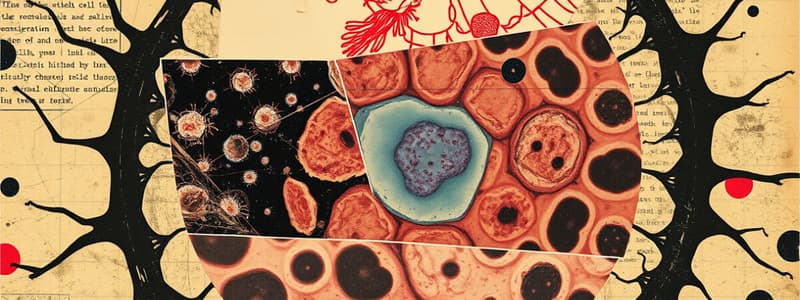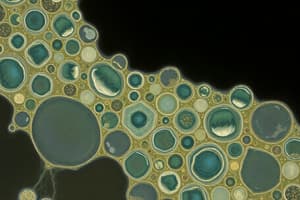Podcast
Questions and Answers
Which of the following is NOT part of cell theory?
Which of the following is NOT part of cell theory?
- All living things are made up of cells
- Cells arise from pre-existing cells
- All cells have a nucleus (correct)
- Cells are the basic unit of life
Eukaryotic cells are generally larger and more complex than prokaryotic cells.
Eukaryotic cells are generally larger and more complex than prokaryotic cells.
True (A)
Name the eight life processes carried out by living organisms.
Name the eight life processes carried out by living organisms.
Movement, Respiration, Sensitivity, Growth, Reproduction, Excretion, Nutrition, and Metabolism
In microscopy, the device used to measure sizes of specimens is called a _______.
In microscopy, the device used to measure sizes of specimens is called a _______.
Match the following types of cells with their characteristics:
Match the following types of cells with their characteristics:
What is the primary function of ribosomes in a eukaryotic cell?
What is the primary function of ribosomes in a eukaryotic cell?
Electron microscopy allows for the observation of live specimens.
Electron microscopy allows for the observation of live specimens.
Describe one difference between plant and animal cells.
Describe one difference between plant and animal cells.
Flashcards are hidden until you start studying
Study Notes
Cell Theory and Structure
- Cell theory states that all living organisms are composed of cells, cells are the basic unit of life, and all cells arise from pre-existing cells.
- Typical cells consist of a plasma membrane, cytoplasm, and genetic material (DNA/RNA).
Making and Staining Cells
- Temporary mounts of cells are created by placing a thin slice of tissue on a microscope slide, adding a drop of stain, and covering it with a cover slip.
- Stains enhance contrast in cells, making specific structures more visible for observation.
Measuring Specimens
- Eyepiece graticules and stage micrometers are tools used to measure specimen sizes under a microscope.
- Calculating actual size involves using the formula: Actual Size = Image Size / Magnification.
Electron Microscopy Applications
- Electron microscopy provides high-resolution images of cell structures, allowing for detailed examination of organelles.
- Useful in research for observing the ultrastructure of cells and viruses.
Microscopy Techniques
- Common techniques include staining, phase contrast microscopy, and fluorescence microscopy, each enhancing visibility of different cellular components.
Common Structures in Cells
- All living cells share structures such as the plasma membrane, cytoplasm, ribosomes, and genetic material.
Prokaryotic Cell Structure
- Prokaryotic cells are simpler, lacking a nucleus and membrane-bound organelles.
- Major components include the cell wall, plasma membrane, ribosomes, plasmids, and genetic material often in a single circular chromosome.
Eukaryotic Cell Structure
- Eukaryotic cells contain a defined nucleus and organelles (e.g., mitochondria, endoplasmic reticulum).
- Functions of organelles include energy production (mitochondria), protein synthesis (ribosomes), and lipid synthesis (smooth ER).
Eight Life Processes
- Living organisms perform eight essential processes: nutrition, respiration, excretion, sensitivity, reproduction, growth, movement, and homeostasis.
Unicellular Organism Processes
- Unicellular organisms complete all eight life processes within one cell, adapting structures for functions (e.g., amoebas can engulf food for nutrition).
Differences in Cell Structure
- Animal cells lack cell walls and chloroplasts, while plant cells have rigid cell walls and plastids, and fungal cells contain chitin in their walls.
Atypical Eukaryotic Cells
- Examples include skeletal muscle fibers, which are multinucleated, and giant algae, some of which can grow to large sizes, challenging traditional cell classification.
Studying That Suits You
Use AI to generate personalized quizzes and flashcards to suit your learning preferences.




